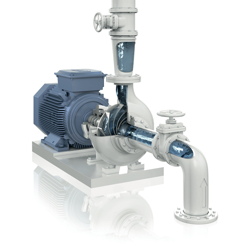Maximising the potential of variable-speed drives

If you have already installed a variable-speed drive, are you sure that it is working at its optimum for you? Carl Turbitt of ABB gives some tips for squeezing the most out of your assets.
If you are already using variable-speed drives (VSDs), there are many little tips that can help ensure you are squeezing the most out of the drives’ performance.
However, first remind yourself why you installed VSDs in the first place. Here are the five most likely reasons.
1.Energy use: Running motors at reduced speed lowers energy use. Compared to conventional motor starting methods, VSDs reduce energy consumption by up to 60%.
2.Environmental improvement: Precise control of air quality leads to a healthier and more comfortable environment.
3.Reduced maintenance: Smooth control reduces mechanical stress on pumps, fans and compressors and leads to reduced maintenance costs.
4.Lower noise: Reduced motor speeds lead to lower noise levels.
5.Greater control: Serial communications and systems integration provide increased level of diagnostics and control.
The best tip of all for controlling your system is to use the functions that are already built in to today’s VSDs. The route to many of the quick fixes is through the keypad, with the many modes available easily selected using navigation keys. Some modes report status of I/O, making it easy to see if control signals are arriving at the drive. Back-up mode ensures there is always a valid list of ‘as commissioned’ parameters to revert back to in case of editing errors.
Here are some more specific functions and quick fixes to consider.
Day-to-day tips
A real-time clock with time and date stamps can be used together with extensive timer functionality and I/O to automate fan or pump control depending on the time of day or night. Such timers can be used to change speed or automatically start or stop a motor, thereby operating like a simple building-management system (BMS).
 |
| VSDs enable air quality to be precisely controlled, which is especially important in buildings such as hospitals |
An audible noise-smoothing mode controls the waveform being delivered to the motor to ensure lowest possible noise, whilst ensuring that the drive does not operate outside its own thermal limits. This reduces noise to inaudible levels to ensure comfort of a building’s residents. Remember, too, that noise is a loss, so reducing noise saves energy.
For outdoor use, installing a VSD outside a control panel reduces the cost of motor cables, installation and panel space. However, it is essential to choose the correct IP rating and mount the drive using the specific rules to allow successful installation, as high IP ratings do not guarantee successful outdoor mounting. Ensure IP21 and IP55 are available as standard, allowing flexible mounting within control rooms or within AHU fan sections without the need for an additional back plate for cooling purposes. This allows for efficient space-saving installation techniques.
Energy tips
HVAC systems are designed for maximum loads, hottest days and for blocked filter worst case scenarios. 85% of the time, however, the actual demand is less than the rated output. Yet some ventilation fans and pumps run at full load — unnecessarily. It is essential that motors are controlled using the least possible energy, so a VSD must automatically detect changes in load and control motor magnets to lowest possible level, thus saving energy. Energy savings can be transmitted via system fieldbus to central logging equipment. A quick win is to ensure that the VSD’s energy optimiser is switched on, which then runs the motor at the lowest possible energy for a given speed and load condition.
Another quick win is to allow the drive to control the motor. Regulations require VSDs to be fitted, but they do not insist that the VSD is actually controlling the motor speed. Remember, the control does not have to be fully variable; just reducing the speed of a motor by a constant fixed amount saves energy as a cube of the speed reduction. So reducing the speed from 50 to 45 Hz (a 10% reduction) results in an energy saving of 27%.
Servicing tips
Clear away the dust. Ensure your VSDs are dust free as particles not only absorb moisture but can also cause a lack of airflow, leading to poor performance from heat sinks and circulating fans.
Keep it dry. VSDs should be treated the same as any electrical equipment and stored in a dry area with no equipment (e.g. dehumidifiers) above that may drip water onto them. Make sure drives can be well ventilated, as humidity and overheating will lead to premature failure.
 |
| Reducing the speed of a motor from 50 to 45Hz (10%) results in an energy saving of 27%. |
Maintain tight connections. Heat cycles and normal mechanical vibration can loosen connections, leading to arcing at the drive output. This can result in over-current faults or even damage to the power components. Poor connections may also cause a drive’s speed to fluctuate, which in some applications can have serious safety implications.
Enable the features in the drive. VSDs contain a number of maintenance and condition-monitoring functions that keep an eye on your process to tell you when maintenance is required, or if a belt has broken or if a filter is blocking. So an easy win is to enable the features that are already there and use the VSD’s intelligence to keep you protected and informed.
Technical tips
Work with a manufacturer that understands the standards and regulations governing drive use and manufactures drives that comply with them.
EMC compliance: IEC/EN 61800-3 (2004) is a specific EMC standard for power drive systems and requires a motor to be connected to a VSD to achieve compliance. In Europe it takes precedence over other generic standards (e.g. EN55011) which do not require motor connection. A HVAC VSD must not exceed the limits for EMC category C2 (EN 61800-3) and so must utilise a class-A EMC filter. For particularly sensitive areas such as hospitals, the use of equipment that meets EMC category C1 (i.e. filter class B) is recommended. To comply with EMC requirements, shielded motor cables should always be used, and a separate equipotential earth bonding cable of at least 16 mm2 should be planned for and installed if required. If long motor cables are needed, cable lengths of 150 m or more may not meet EMC standards. Sinusoidal output filters may be needed if motor insulation is not suitable or if cables are very long.
Harmonics: EN 61000-3-12 is a European standard limiting current harmonic pollution of a single product and is mandatory for products connected to a 400 V network. In the UK, G5/4 takes precedent as a system standard. Swinging choke technology in the drive provides a good start for compliance to EN 6100-3-12 as it reduces harmonic impact as the load on the motor reduces. It also meets UK site-wide standard G5/4-1 where system harmonics are important.
For more top tips visit the link below.
Carl Turbitt is UK sales manager for HVAC Drives at ABB.








